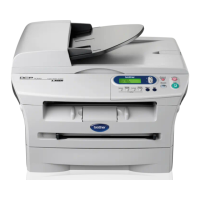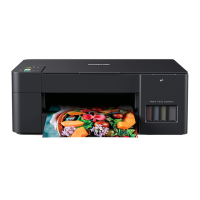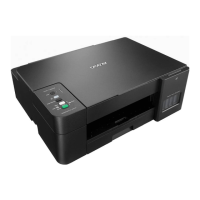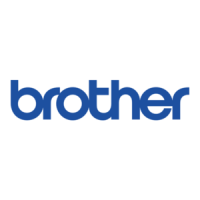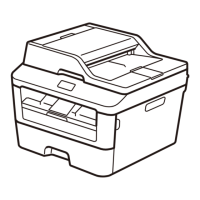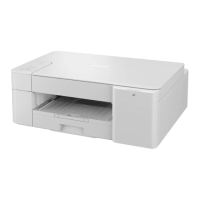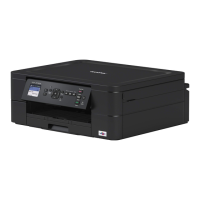What does 'EL Error' mean on my Brother Printer and how to fix it?
- ZZachary JohnsSep 12, 2025
If your Brother printer is showing an 'EL Error', it means the machine has a mechanical problem. Open the front cover and close it again.
What does 'EL Error' mean on my Brother Printer and how to fix it?
If your Brother printer is showing an 'EL Error', it means the machine has a mechanical problem. Open the front cover and close it again.
Why does my Brother Printer say 'Replace Drum'?
The 'Replace Drum' message on your Brother printer indicates that it is time to replace the drum unit. Replace it to resolve the issue.
What to do if Brother DCP-7055 shows 'Out of Memory'?
If your Brother printer displays an 'Out of Memory' message, it means the machine’s memory is full. You can either press Start to copy the scanned pages, or press Stop/Exit and wait for other operations to finish before trying again. Reducing the print resolution can also help.
What does 'Print Unable XX (XX = Error Code)' mean on Brother All in One Printer?
If your Brother All in One Printer displays 'Print Unable XX (XX = Error Code)', it means the machine has a mechanical problem. Disconnect the machine from the AC power outlet for several minutes, then reconnect it.
What does 'Init Unable XX (XX = Error Code)' mean on my Brother DCP-7055 and how to fix it?
If your Brother printer displays 'Init Unable XX (XX = Error Code)', it indicates a mechanical problem. Disconnect the machine from power for several minutes, then reconnect it.
What does 'Fuser Error' mean on Brother All in One Printer and how to fix it?
The 'Fuser Error' on your Brother All in One Printer means the temperature of the fuser unit does not rise to a specified temperature within the specified time. To fix this, turn the power switch off, wait a few seconds, and then turn it on again. Leave the machine for 15 minutes with the power turned on.
What does 'Drum Stop' mean on my Brother DCP-7055 Printer?
The 'Drum Stop' message on your Brother printer means it's time to replace the drum unit.
How to fix Brother Printer 'Duplex Disabled' error?
If your Brother printer says 'Duplex Disabled', the duplex tray is either removed or not correctly installed. Carefully put the duplex tray into the machine until it clicks into place.
What does 'Size Error DX' mean on Brother All in One Printer?
The 'Size Error DX' on your Brother All in One Printer indicates that the paper in the tray is not a suitable size for automatic duplex printing. Load A4 paper for automatic duplex printing, and then press Start.
How to resolve 'Duplex Disabled' on Brother All in One Printer?
If your Brother All in One Printer displays 'Duplex Disabled', the duplex tray is either removed or not correctly installed, or the back of the machine is not closed completely. Carefully put the duplex tray into the machine until it clicks into place or close the back cover of the machine.
Details warnings, cautions, and important notices for safe operation and potential hazards.
Advises against direct sunlight, excessive heat, or blocking ventilation.
Warns about high voltage and electrical shock hazards, advising on safe handling.
Prohibits flammable substances and sprays; advises on toner dust cleaning.
Advises against using the product near water, during electrical storms.
Warns that internal parts can be extremely hot after use and advises against touching shaded areas.
Emphasizes using a three-pin grounded plug and correctly wired extension cords.
Provides specific advice to reduce risks of fire, electric shock, and injury.
Stresses proper grounding and extension cord usage for safety.
Details connecting to AC power and the 3-wire earthed plug.
Recommends surge protectors and emphasizes disconnecting cables before servicing.
Details the product's classification as a Class 1 laser product and internal laser radiation.
Warns that the Class 3B laser diode emits invisible radiation and the unit should not be opened.
Explains the machine can feed from the standard paper tray or manual feed slot.
Details how to load paper up to 250 sheets into the standard paper tray.
Instructs on sliding guides to fit paper size and ensuring correct paper placement.
Advises on paper level, print side, and guide contact for proper feeding.
Explains loading envelopes and special media one at a time into the manual feed slot.
Details printing on plain or recycled paper using the manual feed slot.
Describes using the back output tray for a straight path for thick paper, labels, or envelopes.
Guides on sliding manual feed slot guides to match paper width.
Details placing paper into the manual feed slot until the roller engages.
Lists usable media like thin, plain, thick paper, labels, and envelopes.
Explains copying and scanning from ADF or scanner glass.
Details ADF capacity, paper type, and steps for loading documents into the ADF.
Guides on placing documents face down on the scanner glass for copying or scanning.
Outlines the fundamental steps for making a copy using ADF or scanner glass.
Lists changeable copy settings such as Enlarge/Reduce, Quality, and Brightness.
Guides on installing the Brother printer driver from the CD-ROM.
Details selecting machine, properties, and various print settings like Paper Size and Orientation.
Explains scanning using the machine's Scan key or computer scanner drivers.
Steps for scanning directly from the machine to a PC, choosing modes like File, E-mail, OCR, Image.
Guides on starting a scanning application and adjusting settings like Resolution and Brightness.
Explains when to replace toner cartridges and drum units and advises purchasing spares.
Recommends genuine Brother cartridges and warns against refilling for optimal performance.
Explains the 'Toner Low' message and advises purchasing a new cartridge.
Provides steps for replacing the toner cartridge, including cooling down the machine.
Warns against putting toner into fire and using flammable cleaning agents.
Instructs on unpacking the new cartridge just before use to maintain toner life.
Guides on firmly inserting the toner cartridge into the drum unit until it locks.
Recommends genuine Brother drum units and cartridges for best performance and warranty.
Addresses 'Drum Error' by cleaning the corona wire or replacing the drum unit.
Warns about extremely hot internal parts after use and advises against touching shaded areas.
Warns against touching electrodes to prevent damage from static electricity.
Advises careful handling of the drum unit/toner to prevent toner scattering and immediate cleanup.
Instructs on unpacking the new drum unit just before use and avoiding sunlight/room light.
Guides on firmly inserting the toner cartridge into the new drum unit until it locks.
Provides steps to reset the drum counter after replacing the drum unit.
Warns about extremely hot internal parts and advises waiting for cooling.
Advises careful handling of the toner cartridge and avoiding shaded parts.
Lists common error messages like Cartridge Error, Cooling Down, Cover is Open, Drum Error.
Explains troubleshooting for paper jams in the duplex tray or inside the machine.
Addresses paper jams at the back, in the tray, and 'No Paper' status.
Provides solutions for memory issues and print failures indicated by error codes.
Explains messages related to replacing drum units and toner cartridges.
Steps to clear paper jams at the top of the ADF unit.
Steps to clear paper jams under the document cover in the ADF.
Guides on removing small paper scraps from the ADF using stiff paper.
Steps to clear paper jams at the output tray.
Detailed steps to remove paper jammed in the standard paper tray.
Guides on clearing paper jams occurring behind the back cover.
Warns about hot internal parts when accessing the rear of the machine.
Guides on gently pulling jammed paper out of the fuser unit.
Warns about extremely hot parts when accessing the fuser unit.
Guides on removing the drum/toner assembly to clear internal jams.
Advises careful handling of the toner cartridge and avoiding shaded parts.
Guides on reinstalling the toner cartridge and drum assembly after clearing a jam.
Guides on pulling jammed paper from the output tray opening.
Guides on removing the paper tray to clear jams from its opening.
Steps to clear paper jams specifically from the duplex tray.
Warns about hot internal parts when accessing the duplex tray area.
Guides on pulling jammed paper out of the machine or duplex tray.
Covers issues like poor print quality, no printout, and checking machine status.
Addresses problems like the machine not feeding paper or showing 'No Paper' or 'Paper Jam'.
Guides on resolving issues with printing over a wired network connection.
Addresses problems with network scanning features and computer detection.
Explains power surge effects and how to reset safety mechanisms.
Guides on checking paper, cartridge installation, and environment for print quality.
Details approximate page yields for starter, standard, and high-yield toner cartridges.
Explains using temporary COPY keys for settings like Quality, Stack, and Sort.
Details warnings, cautions, and important notices for safe operation and potential hazards.
Advises against direct sunlight, excessive heat, or blocking ventilation.
Warns about high voltage and electrical shock hazards, advising on safe handling.
Prohibits flammable substances and sprays; advises on toner dust cleaning.
Advises against using the product near water, during electrical storms.
Warns that internal parts can be extremely hot after use and advises against touching shaded areas.
Emphasizes using a three-pin grounded plug and correctly wired extension cords.
Provides specific advice to reduce risks of fire, electric shock, and injury.
Stresses proper grounding and extension cord usage for safety.
Details connecting to AC power and the 3-wire earthed plug.
Recommends surge protectors and emphasizes disconnecting cables before servicing.
Details the product's classification as a Class 1 laser product and internal laser radiation.
Warns that the Class 3B laser diode emits invisible radiation and the unit should not be opened.
Explains the machine can feed from the standard paper tray or manual feed slot.
Details how to load paper up to 250 sheets into the standard paper tray.
Instructs on sliding guides to fit paper size and ensuring correct paper placement.
Advises on paper level, print side, and guide contact for proper feeding.
Explains loading envelopes and special media one at a time into the manual feed slot.
Details printing on plain or recycled paper using the manual feed slot.
Describes using the back output tray for a straight path for thick paper, labels, or envelopes.
Guides on sliding manual feed slot guides to match paper width.
Details placing paper into the manual feed slot until the roller engages.
Lists usable media like thin, plain, thick paper, labels, and envelopes.
Explains copying and scanning from ADF or scanner glass.
Details ADF capacity, paper type, and steps for loading documents into the ADF.
Guides on placing documents face down on the scanner glass for copying or scanning.
Outlines the fundamental steps for making a copy using ADF or scanner glass.
Lists changeable copy settings such as Enlarge/Reduce, Quality, and Brightness.
Guides on installing the Brother printer driver from the CD-ROM.
Details selecting machine, properties, and various print settings like Paper Size and Orientation.
Explains scanning using the machine's Scan key or computer scanner drivers.
Steps for scanning directly from the machine to a PC, choosing modes like File, E-mail, OCR, Image.
Guides on starting a scanning application and adjusting settings like Resolution and Brightness.
Explains when to replace toner cartridges and drum units and advises purchasing spares.
Recommends genuine Brother cartridges and warns against refilling for optimal performance.
Explains the 'Toner Low' message and advises purchasing a new cartridge.
Provides steps for replacing the toner cartridge, including cooling down the machine.
Warns against putting toner into fire and using flammable cleaning agents.
Instructs on unpacking the new cartridge just before use to maintain toner life.
Guides on firmly inserting the toner cartridge into the drum unit until it locks.
Recommends genuine Brother drum units and cartridges for best performance and warranty.
Addresses 'Drum Error' by cleaning the corona wire or replacing the drum unit.
Warns about extremely hot internal parts after use and advises against touching shaded areas.
Warns against touching electrodes to prevent damage from static electricity.
Advises careful handling of the drum unit/toner to prevent toner scattering and immediate cleanup.
Instructs on unpacking the new drum unit just before use and avoiding sunlight/room light.
Guides on firmly inserting the toner cartridge into the new drum unit until it locks.
Provides steps to reset the drum counter after replacing the drum unit.
Warns about extremely hot internal parts and advises waiting for cooling.
Advises careful handling of the toner cartridge and avoiding shaded parts.
Lists common error messages like Cartridge Error, Cooling Down, Cover is Open, Drum Error.
Explains troubleshooting for paper jams in the duplex tray or inside the machine.
Addresses paper jams at the back, in the tray, and 'No Paper' status.
Provides solutions for memory issues and print failures indicated by error codes.
Explains messages related to replacing drum units and toner cartridges.
Steps to clear paper jams at the top of the ADF unit.
Steps to clear paper jams under the document cover in the ADF.
Guides on removing small paper scraps from the ADF using stiff paper.
Steps to clear paper jams at the output tray.
Detailed steps to remove paper jammed in the standard paper tray.
Guides on clearing paper jams occurring behind the back cover.
Warns about hot internal parts when accessing the rear of the machine.
Guides on gently pulling jammed paper out of the fuser unit.
Warns about extremely hot parts when accessing the fuser unit.
Guides on removing the drum/toner assembly to clear internal jams.
Advises careful handling of the toner cartridge and avoiding shaded parts.
Guides on reinstalling the toner cartridge and drum assembly after clearing a jam.
Guides on pulling jammed paper from the output tray opening.
Guides on removing the paper tray to clear jams from its opening.
Steps to clear paper jams specifically from the duplex tray.
Warns about hot internal parts when accessing the duplex tray area.
Guides on pulling jammed paper out of the machine or duplex tray.
Covers issues like poor print quality, no printout, and checking machine status.
Addresses problems like the machine not feeding paper or showing 'No Paper' or 'Paper Jam'.
Guides on resolving issues with printing over a wired network connection.
Addresses problems with network scanning features and computer detection.
Explains power surge effects and how to reset safety mechanisms.
Guides on checking paper, cartridge installation, and environment for print quality.
Details approximate page yields for starter, standard, and high-yield toner cartridges.
Explains using temporary COPY keys for settings like Quality, Stack, and Sort.
| Scan speed | 2.63 sec/page |
|---|---|
| Dimensions (WxDxH) | 405 x 399 x 268 mm |
| Energy saving mode | Yes |
| All-in-one functions | Copy, Print, Scan |
| Color all-in-one functions | Scan |
| Duplex printing | No |
| Print technology | Laser |
| Maximum resolution | 2400 x 600 DPI |
| Time to first page (black, normal) | 10 s |
| Print speed (black, normal quality, A4/US Letter) | 20 ppm |
| Maximum duty cycle | - pages per month |
| Recommended duty cycle | 250 - 1600 pages per month |
| Page description languages | GDI |
| Copier resize | 25 - 400 % |
| Maximum copy resolution | 600 x 600 DPI |
| Maximum number of copies | 99 copies |
| N-in-1 copy function (N=) | 2, 4, 9, 16, 25 |
| Time to first copy (black, normal) | 12 s |
| Copy speed (black, normal quality, A4) | 20 cpm |
| Scan to | E-mail, File, Image, OCR |
| Scanner type | Flatbed scanner |
| Grayscale levels | 256 |
| Input color depth | 48 bit |
| Output color depth | 24 bit |
| Image formats supported | BMP, JPG, TIF |
| Maximum scan resolution | 19200 x 19200 DPI |
| Optical scanning resolution | 600 x 2400 DPI |
| Total input capacity | 250 sheets |
| Total output capacity | 100 sheets |
| Multi-Purpose tray input capacity | 1 sheets |
| Custom media width | 76.2 - 216 mm |
| Maximum print size | 216 x 406 mm |
| Custom media length | 116 - 406.4 mm |
| Paper tray media types | Bond paper, Plain paper, Recycled paper |
| Paper tray media weight | 60 - 105 g/m² |
| ISO A-series sizes (A0...A9) | A4, A5, A6 |
| ISO B-series sizes (B0...B9) | B5, B6 |
| Multi-purpose tray media types | Bond paper, Envelopes, Heavyweight paper, Plain paper, Recycled paper |
| Maximum ISO A-series paper size | A4 |
| Multi-Purpose Tray media weight | 60 - 163 g/m² |
| Display | LCD |
| Market positioning | Home & office |
| Display number of lines | 2 lines |
| Display number of characters | 16 |
| Standard interfaces | USB 2.0 |
| USB 2.0 ports quantity | 1 |
| Internal memory | 16 MB |
| Processor family | ARM |
| Sound power level (standby) | 30 dB |
| Sound pressure level (printing) | 53 dB |
| AC input voltage | 220 - 240 V |
| AC input frequency | 50 - 60 Hz |
| Power consumption (standby) | 45 W |
| Power consumption (PowerSave) | 0.9 W |
| Power consumption (average operating) | 445 W |
| Sustainability certificates | ENERGY STAR |
| Package weight | 12900 g |
| Mac operating systems supported | Mac OS X 10.4 Tiger, Mac OS X 10.5 Leopard, Mac OS X 10.6 Snow Leopard, Mac OS X 10.7 Lion |
| Windows operating systems supported | Windows 2000 Professional, Windows 7 Home Premium, Windows 7 Home Premium x64, Windows 7 Professional, Windows 7 Professional x64, Windows 7 Ultimate, Windows 7 Ultimate x64, Windows Vista Business, Windows Vista Business x64, Windows Vista Home Basic, Windows Vista Home Basic x64, Windows Vista Home Premium, Windows Vista Home Premium x64, Windows Vista Ultimate, Windows Vista Ultimate x64, Windows XP Home, Windows XP Home x64, Windows XP Professional, Windows XP Professional x64 |

